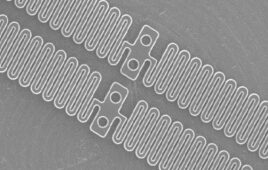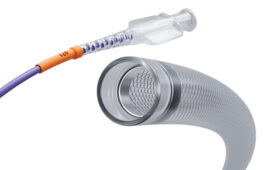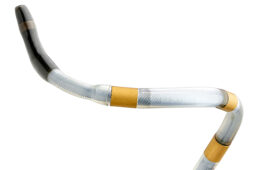
This glowing star inspired glow-in-the-dark COVID-19 testing technology developed by Richard Willson and his team at the University of Houston. [Image courtesy of the University of Houston)
Researchers at the University of Houston are using glow-in-the-dark materials to enhance the sensitivity of rapid COVID-19 home diagnostics.
The widely used lateral flow assay provides rapid results for diagnostics such as at-home COVID-19 or pregnancy tests. They also offer low costs and ease of operation. Test results on LFA diagnostics come through in colored lines.
“We are making those lines glow-in-the-dark so that they are more detectable, so the sensitivity of the test is better,” said Richard Willson, who’s leading the University of Houston team.
Willson is the Huffington-Woestemeyer professor of chemical and biomolecular engineering at the UH Drug Discovery Institute and a professor of biochemical and biophysical sciences. He previously created a COVID smartphone-based app and test kit based on the technology underlying home pregnancy tests.
Willson conceived of the approach while looking at a glowing star on his young daughter’s bedroom ceiling. Within days of wondering how those principles apply to science, Willson and his team created a test with glowing nanoparticles. These nanoparticles, made of phosphors, make the particles even more detectable and the tests more accurate.
Two of the students involved in this effort founded Luminostics (now called Clip Health), a spinoff from the Willson lab. The current team in the lab continues to develop this application.
How the glow-in-the-dark tests work
“In this new development, there are two tricks,” Willson explained in the Royal Society of Chemistry journal Analyst. “First, we use enzymes, proteins that catalyze reactions, to drive reactions that emit light, like a firefly. Second, we attached those light-emitting enzymes onto harmless virus particles, along with antibodies that bind to COVID proteins.”
According to the team, one antibody on a virus can bind to one COVID target on the test strip. It brings along with it many light-emitting enzymes. The team gets more light for each target, needing fewer targets to see the light and making the test more sensitive.
Willson and his team also created a plastic box to exclude light and let a smartphone camera read the results. According to Willson, the sensitivity is “really excellent, better than essentially any commercial tests.” He said it makes the technology useful in an array of medical arenas.
“This technology can be used for detecting all kinds of other things, including flu and HIV, but also Ebola and biodefense agents, and maybe toxins and environmental contaminants and pesticides in food,” said Willson.
The Houston team
Willson’s lab is at the William A. Brookshire Department of Chemical and Biomolecular Engineering in the UH Cullen College of Engineering.
The paper’s first authors were Maede Chabi and Kristen Brosamer from the department of biomedical engineering, Binh Vu and Maxwell Smith from chemical and biomolecular engineering, and Dimple Chavan from biology and biochemistry.
Willson was a corresponding author on the paper, along with UH research associate professor of chemical and biomolecular engineering Katerina Kourentzi and Jacinta Conrad, the Frank M. Tiller associate professor of chemical and biomolecular engineering.




